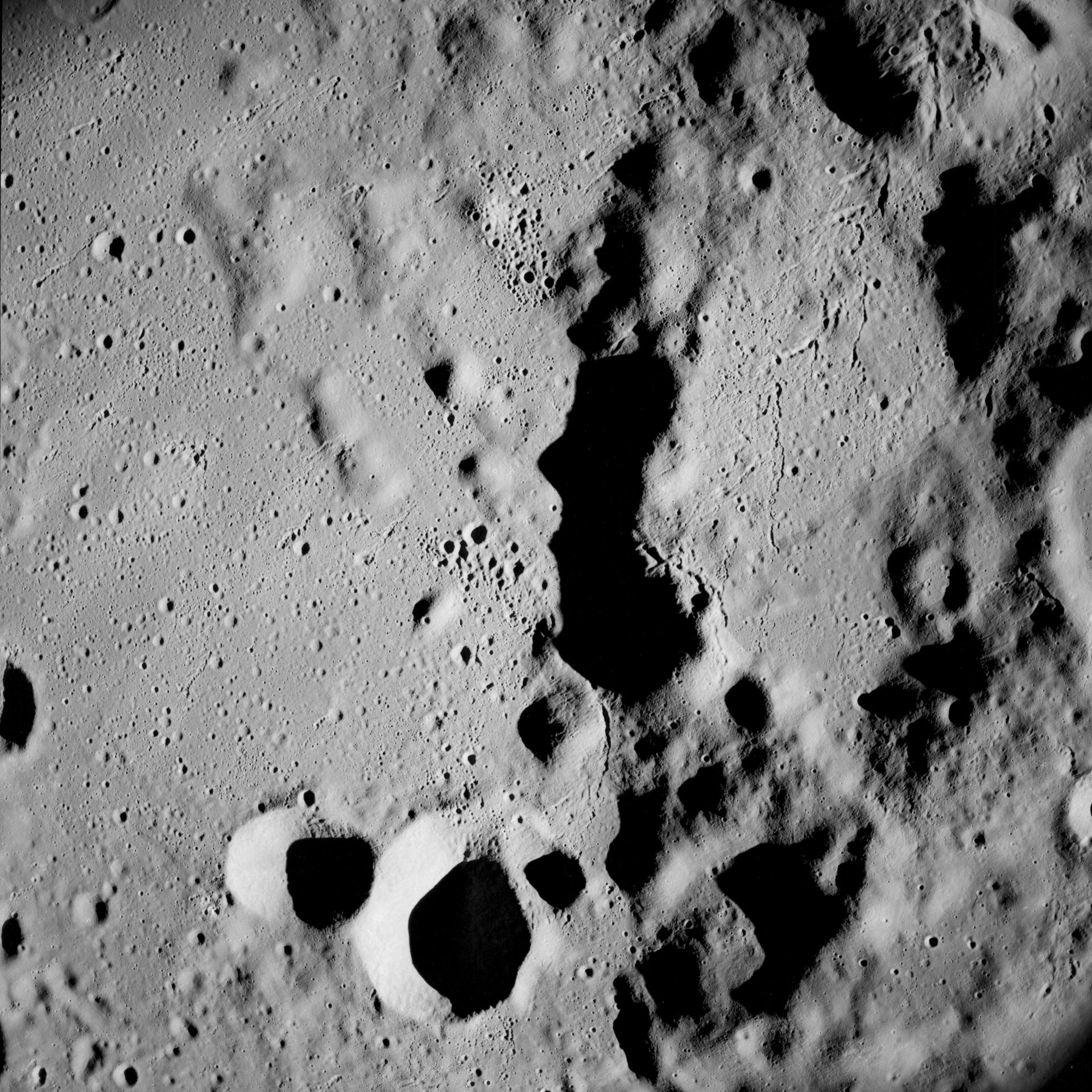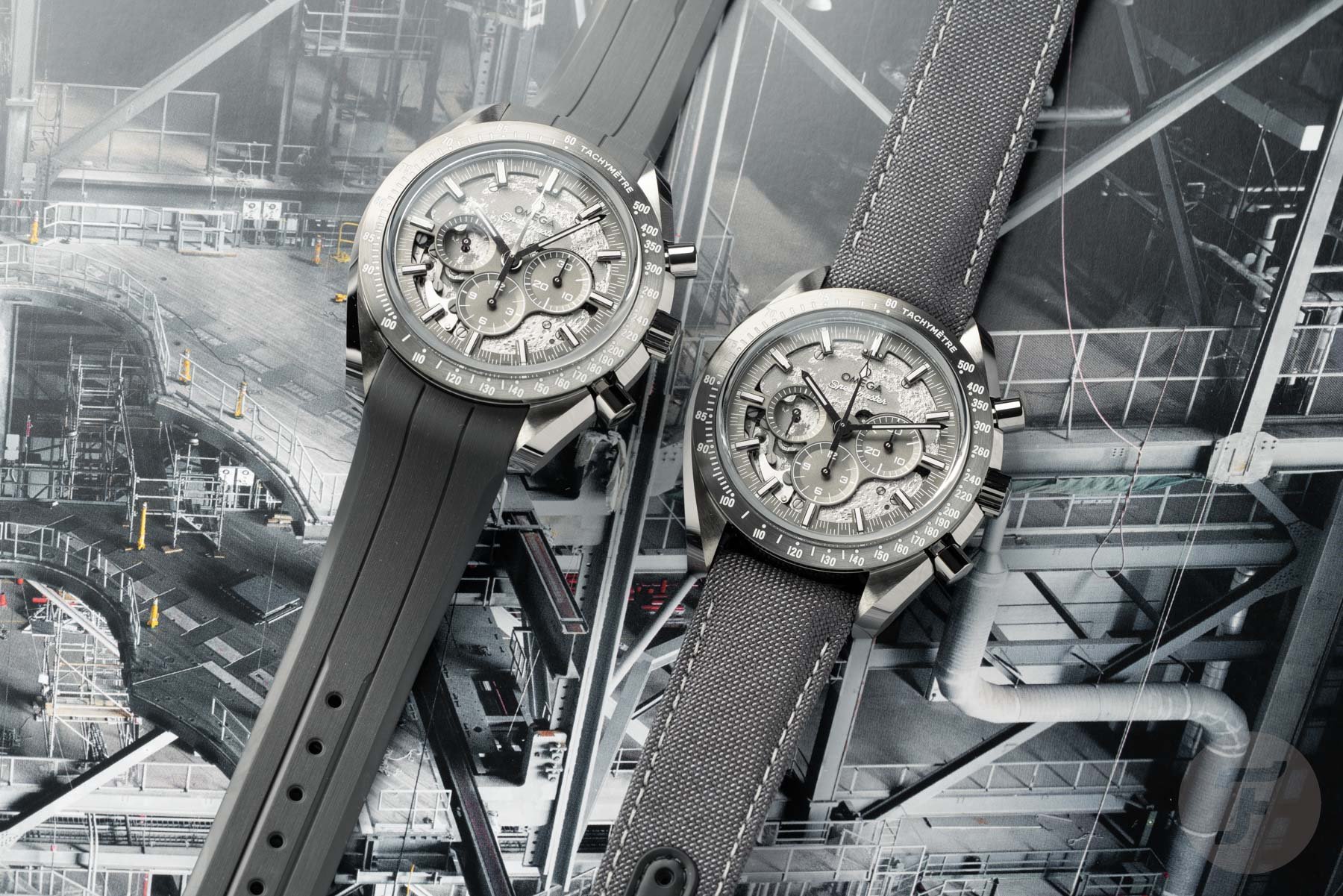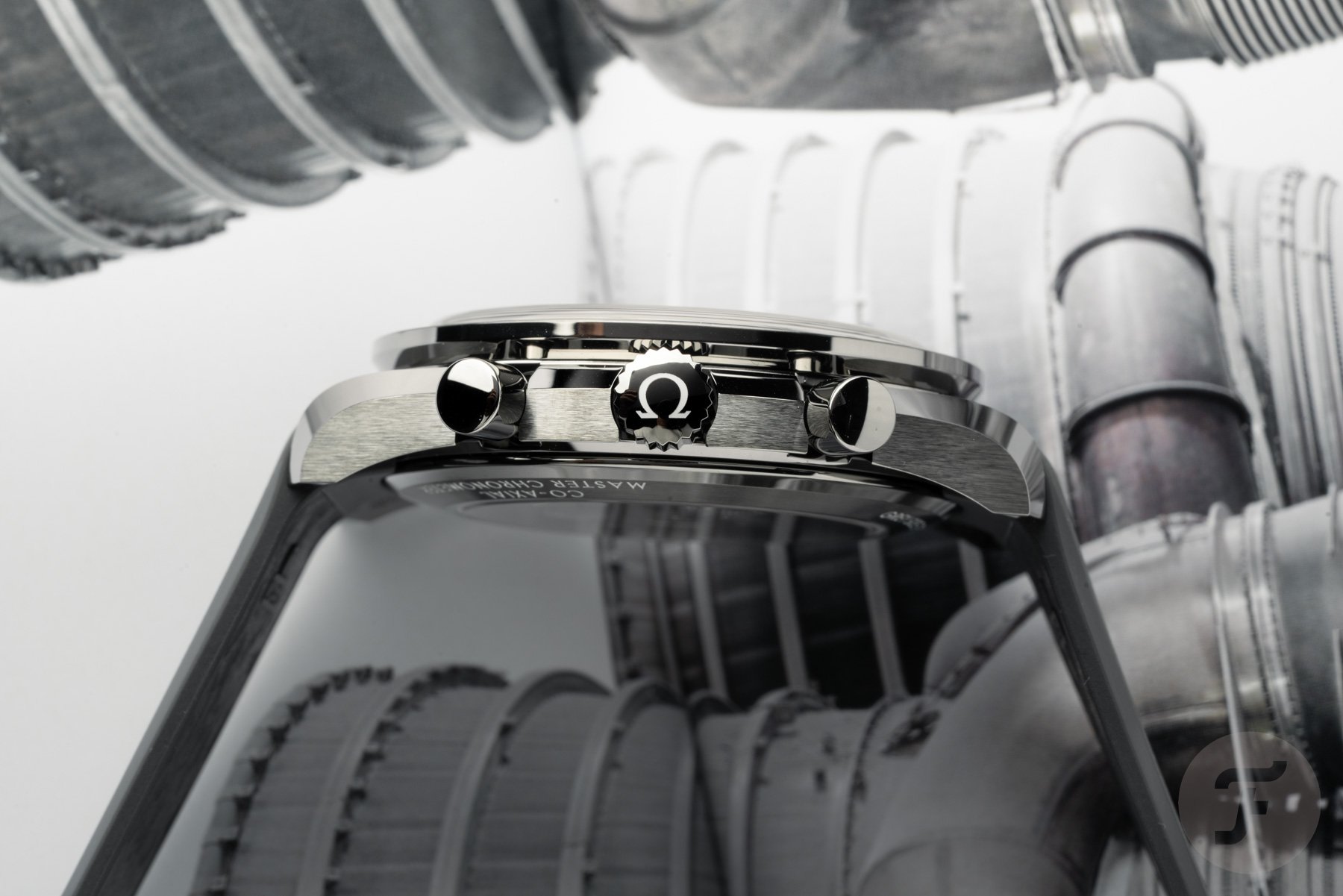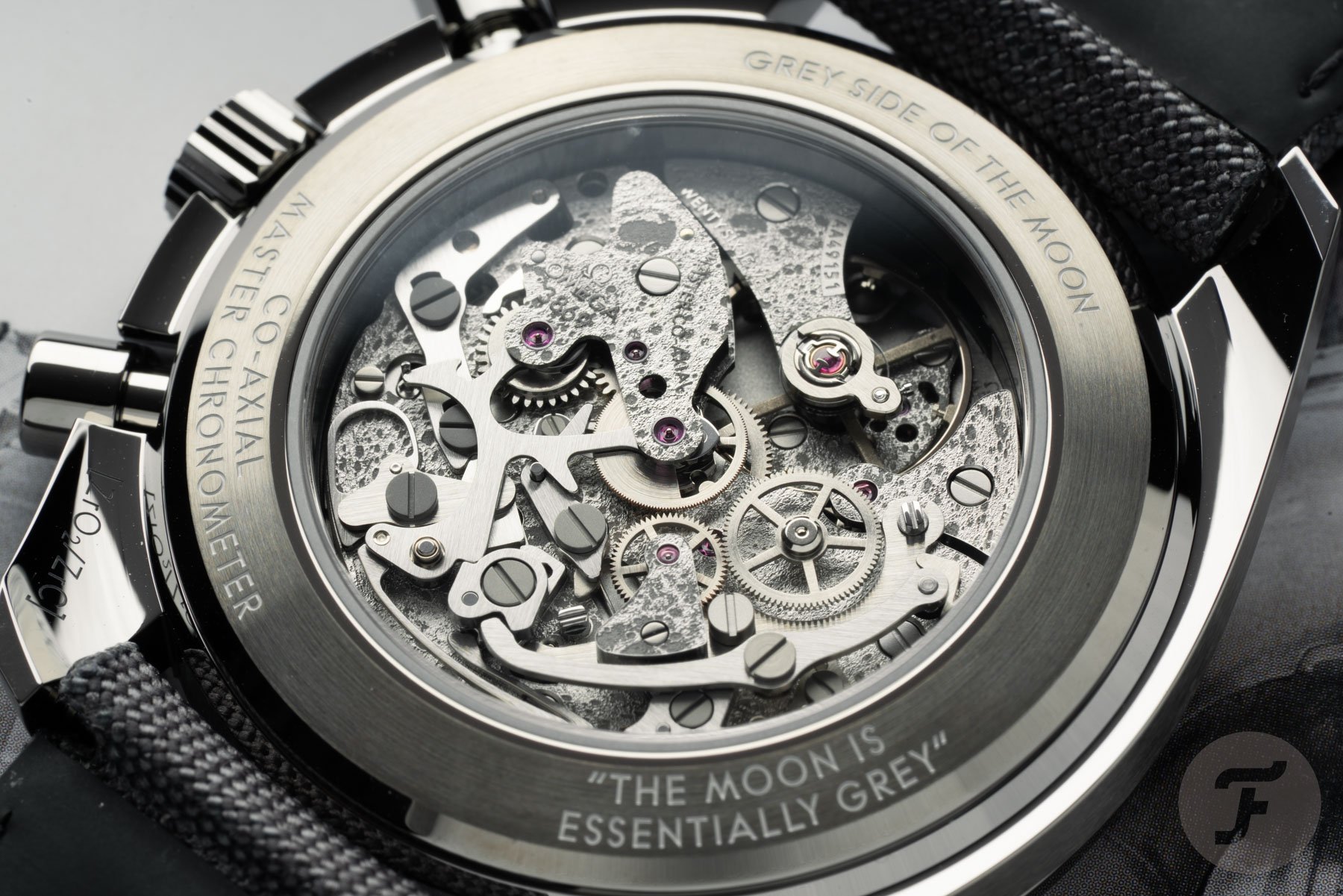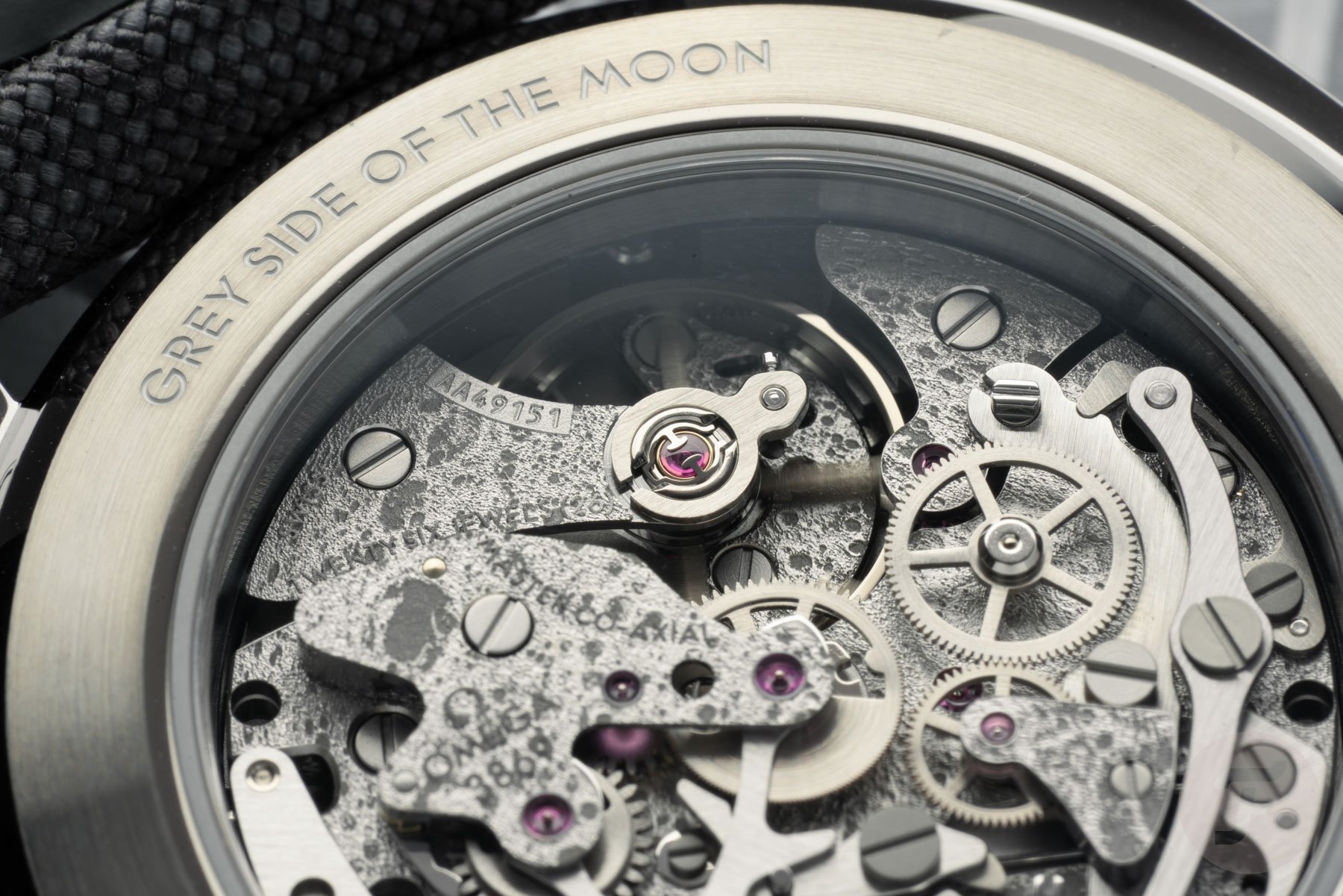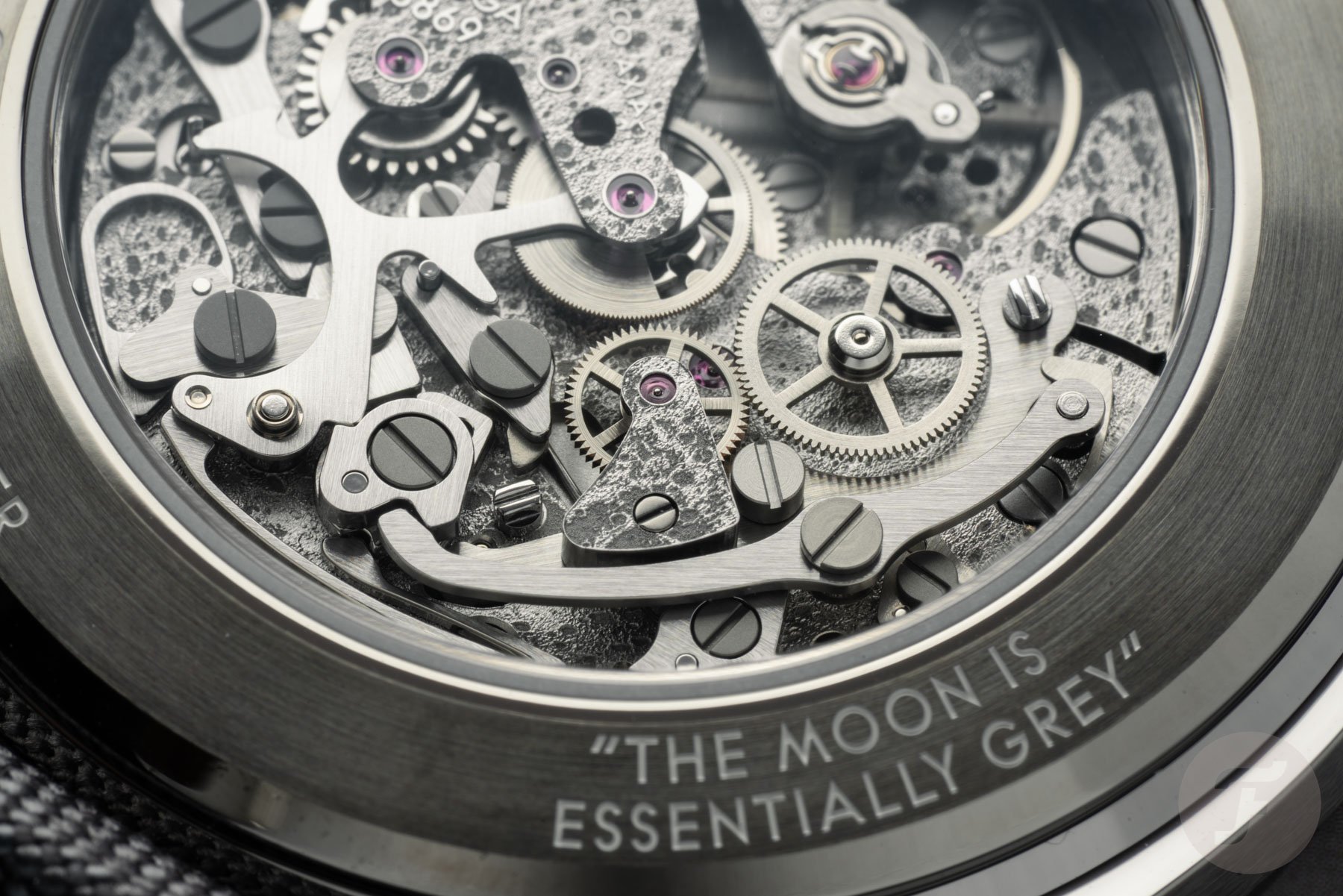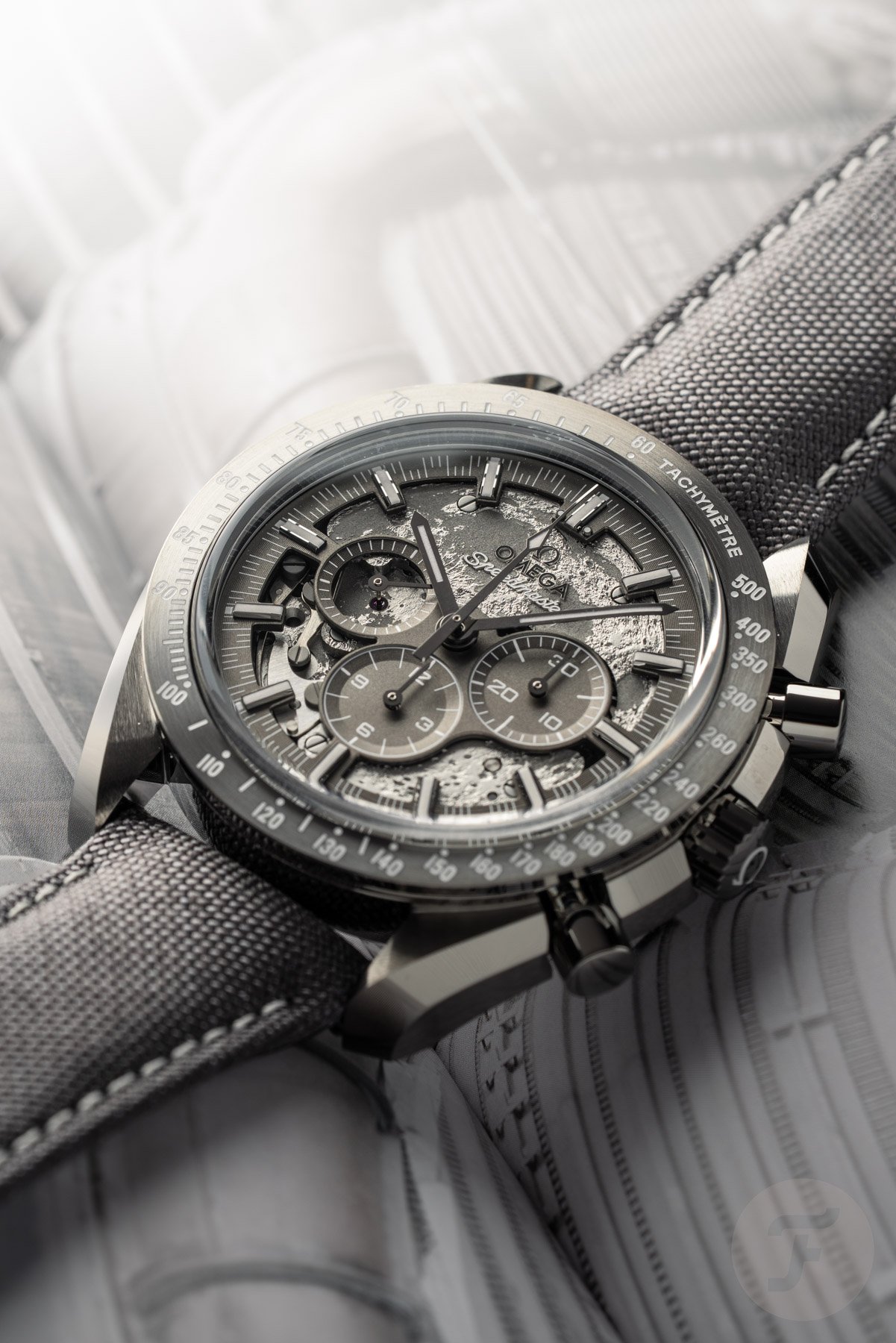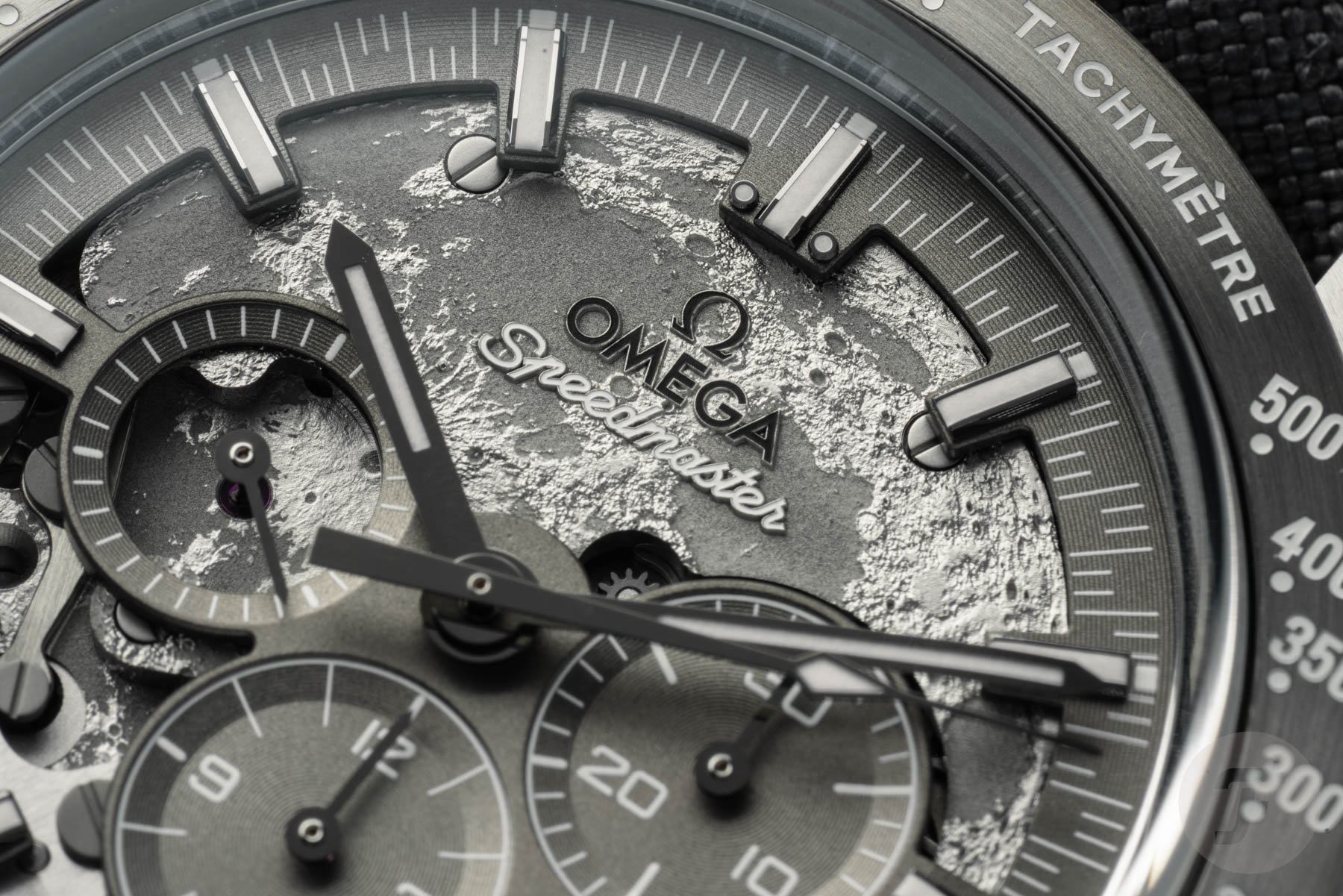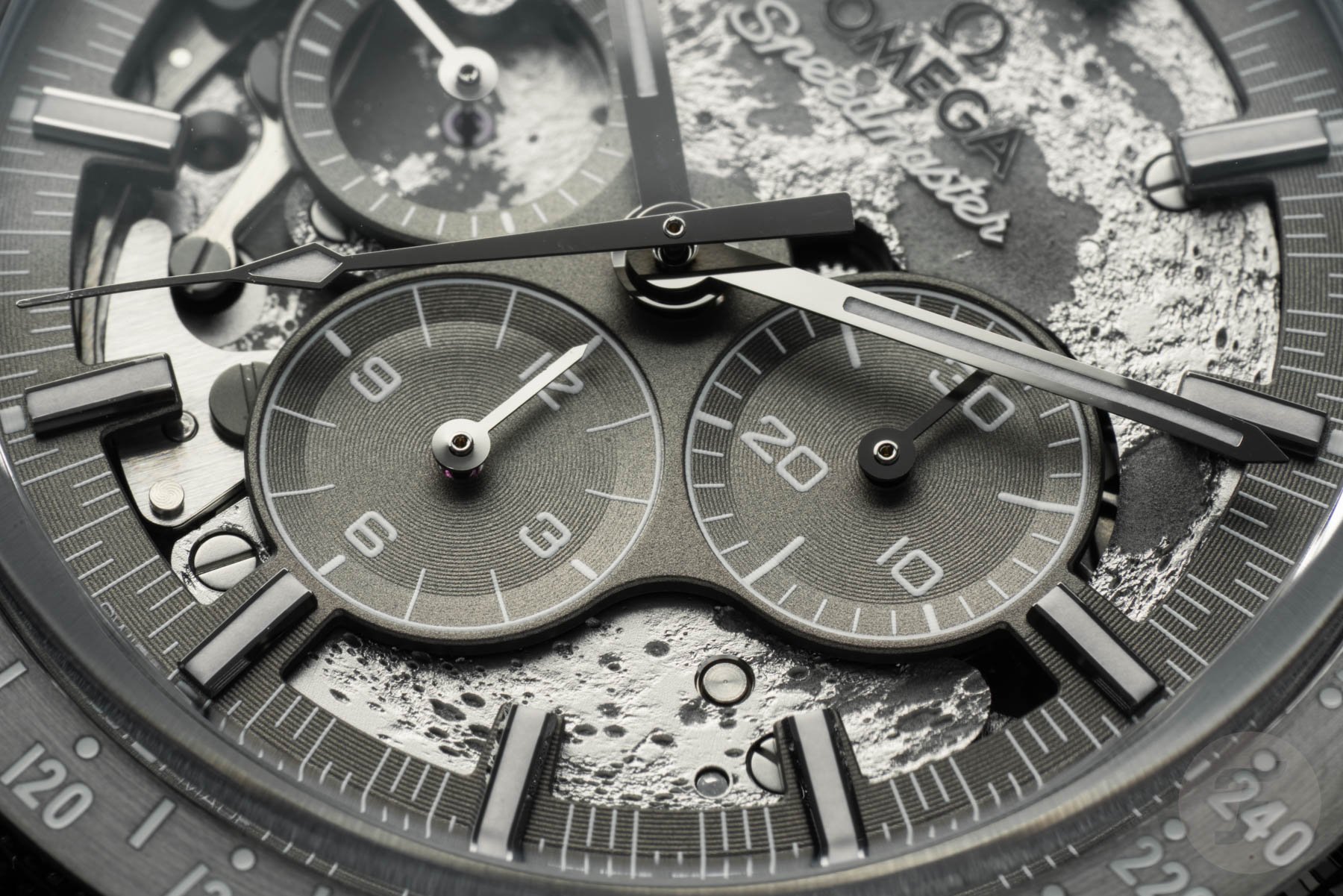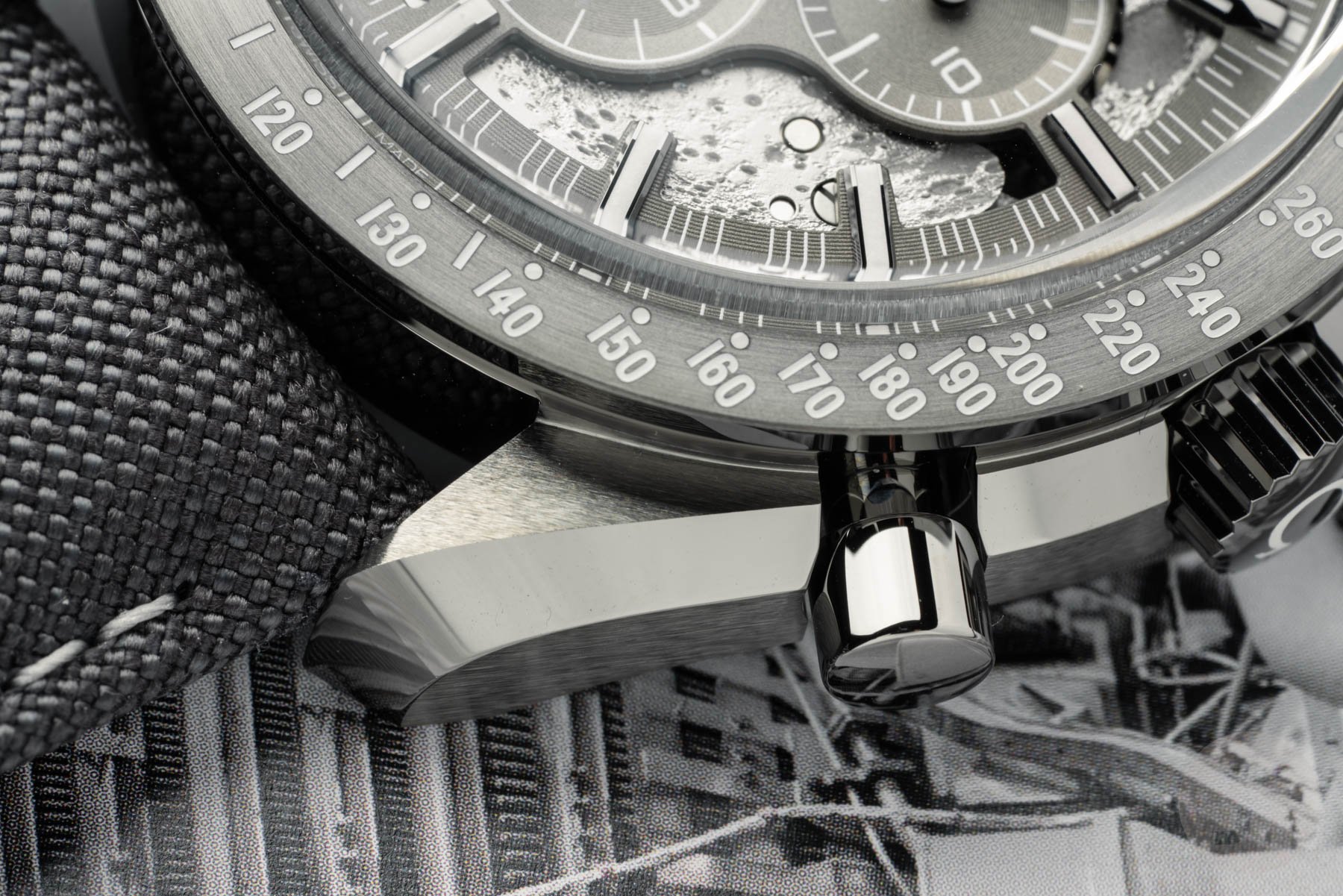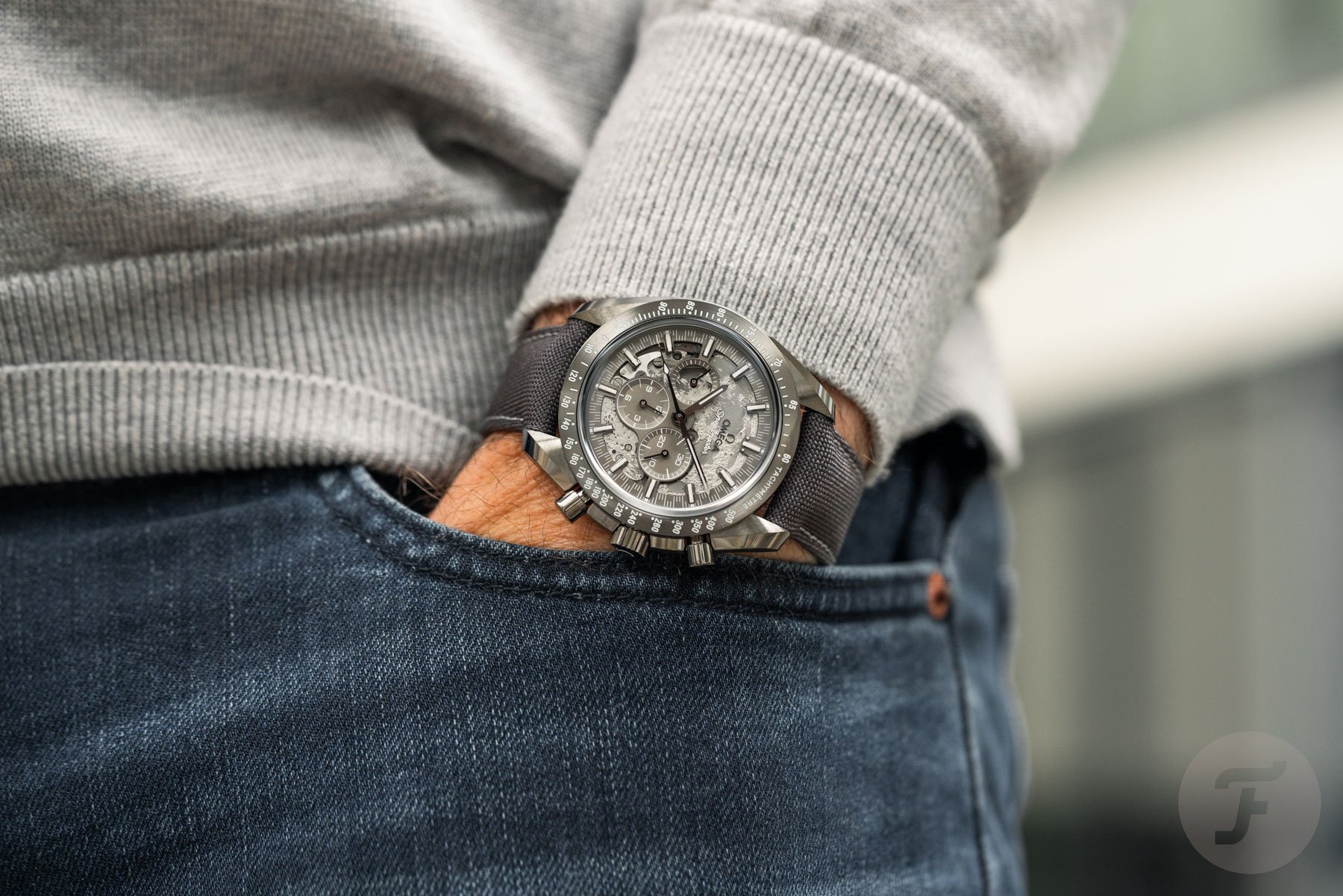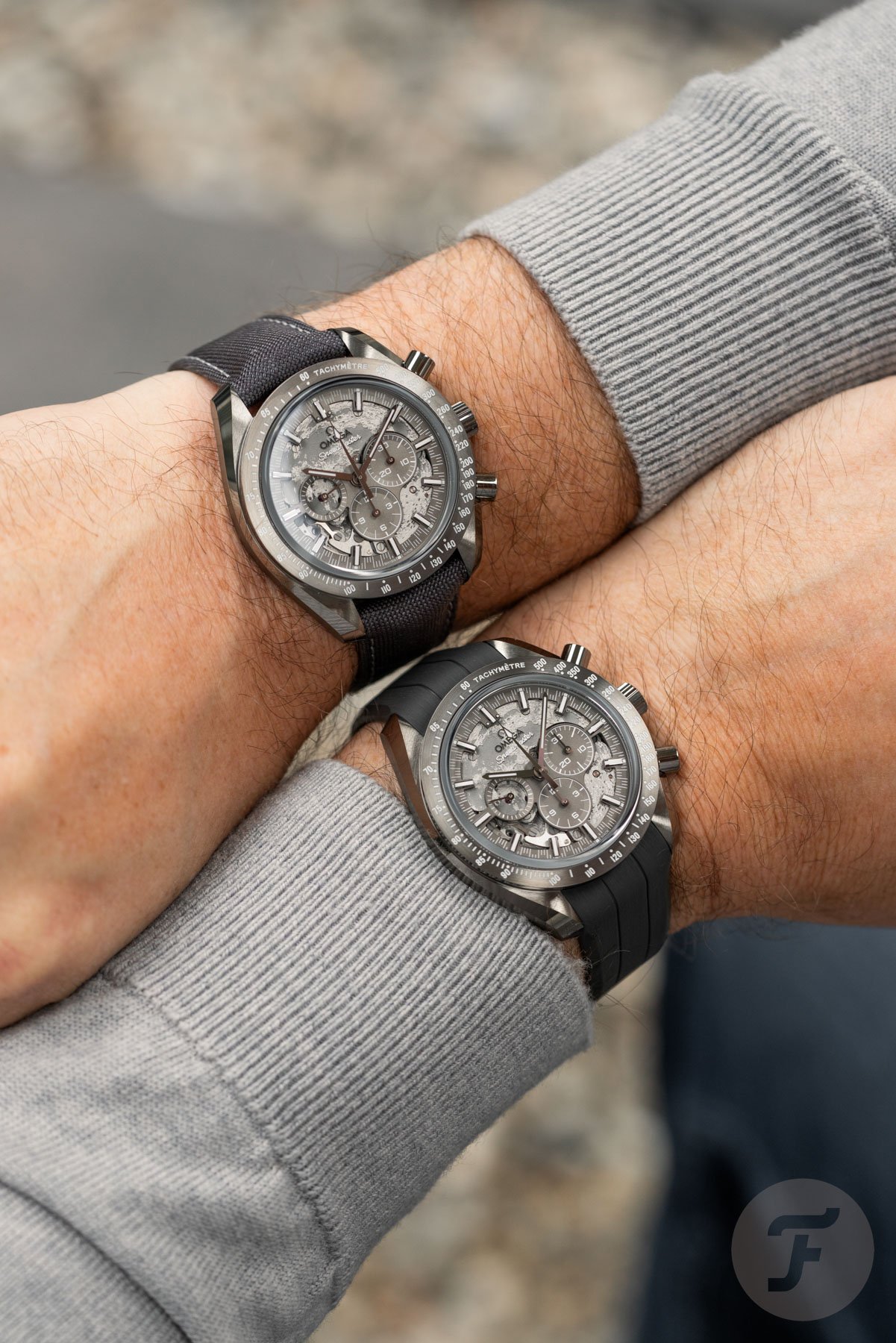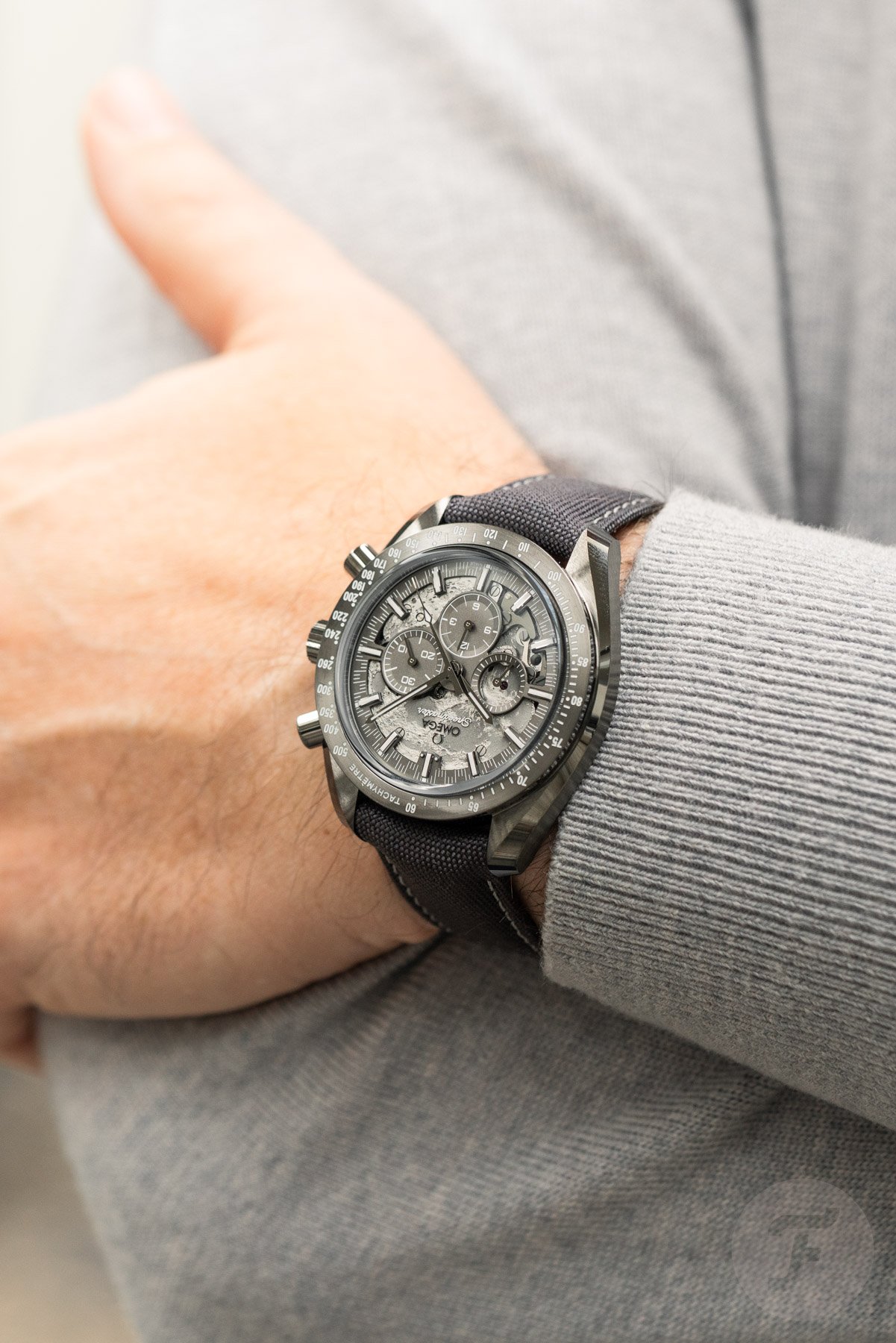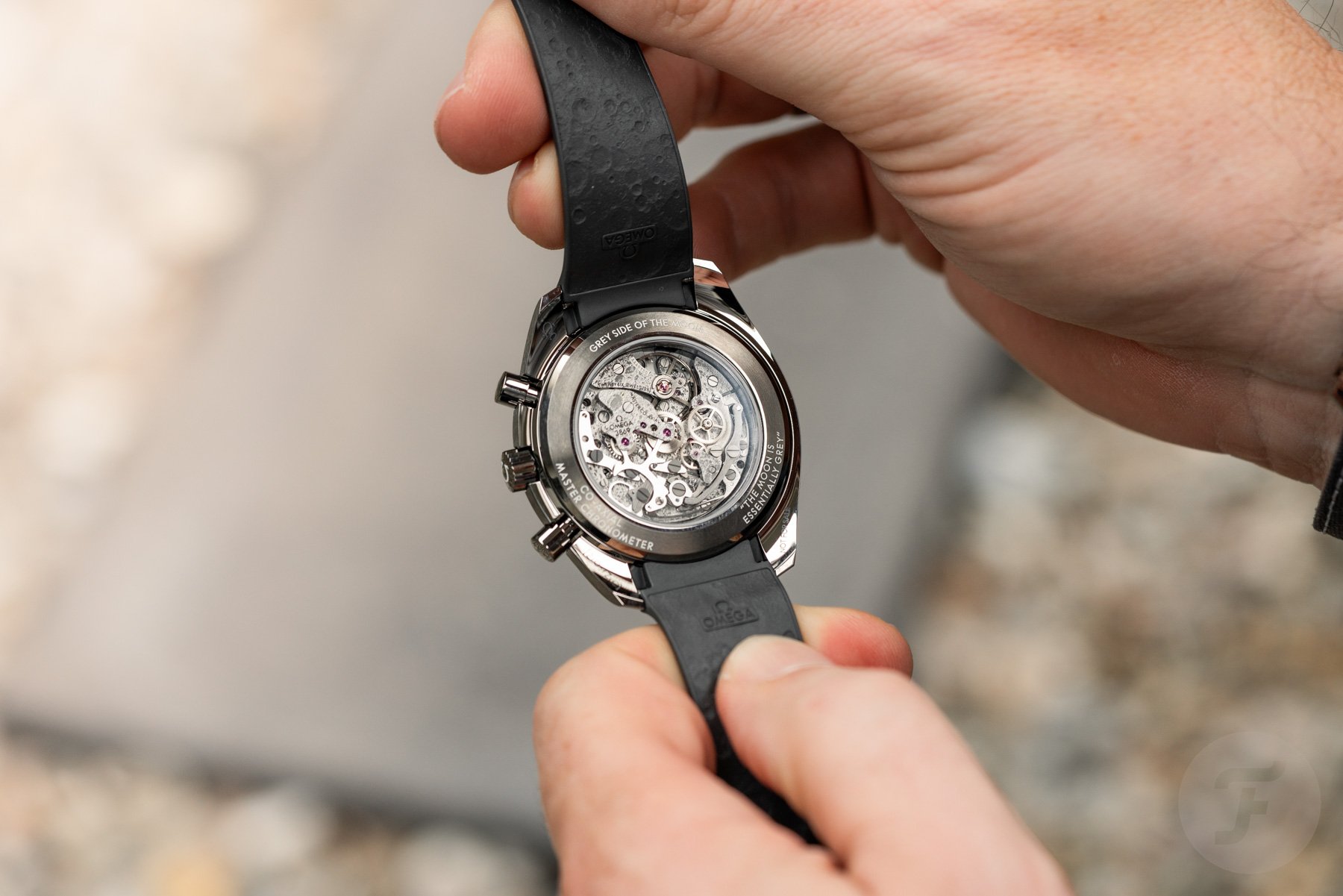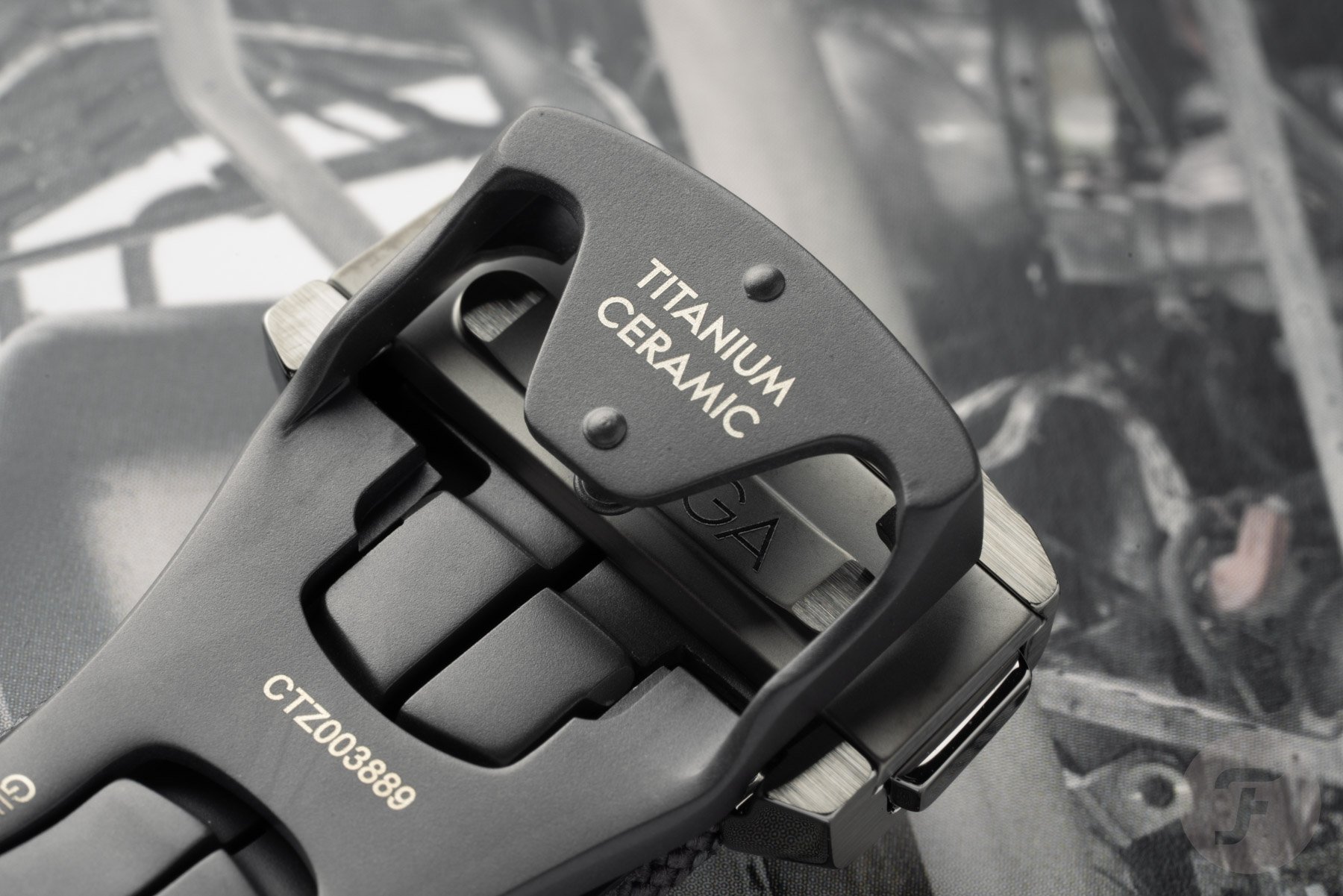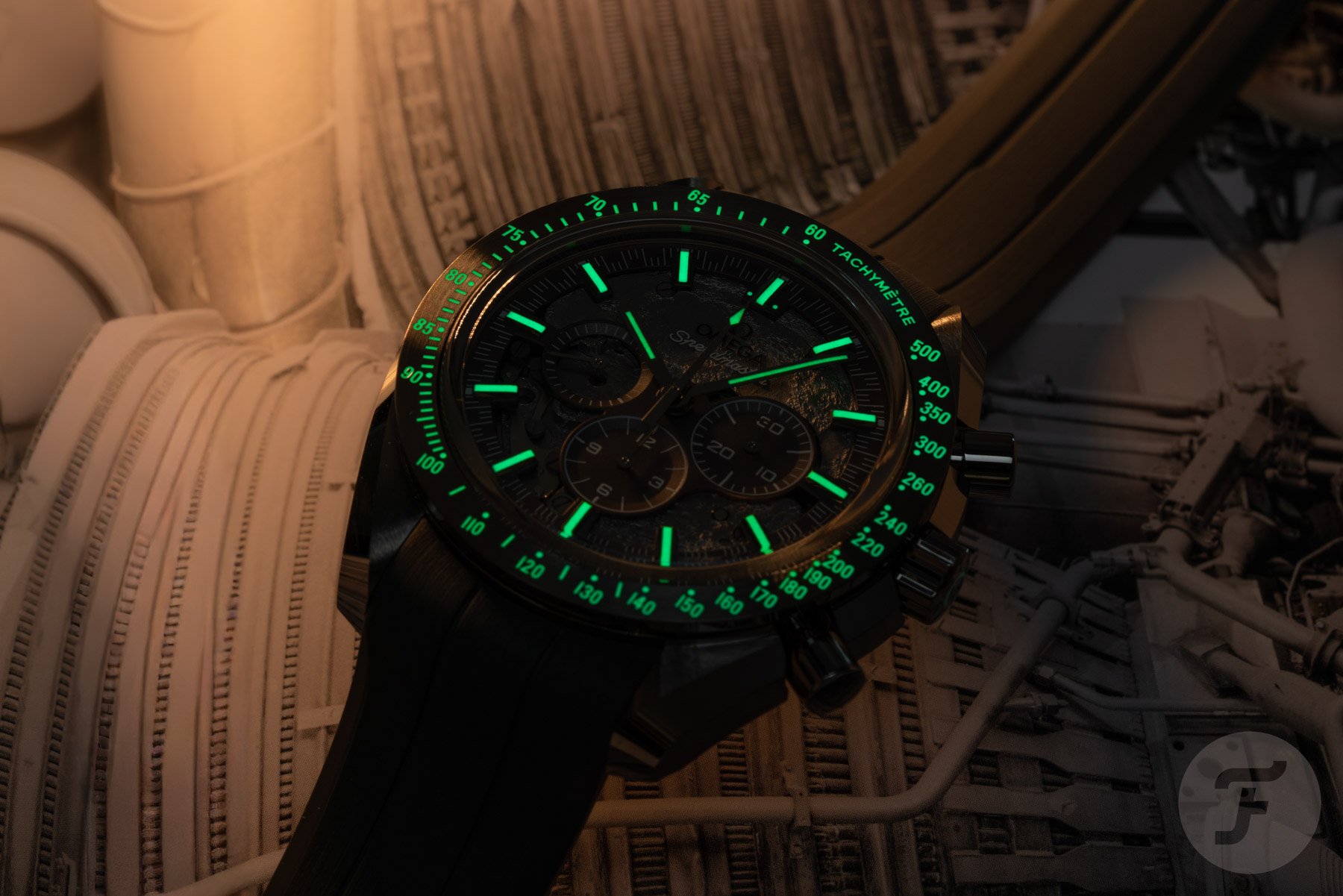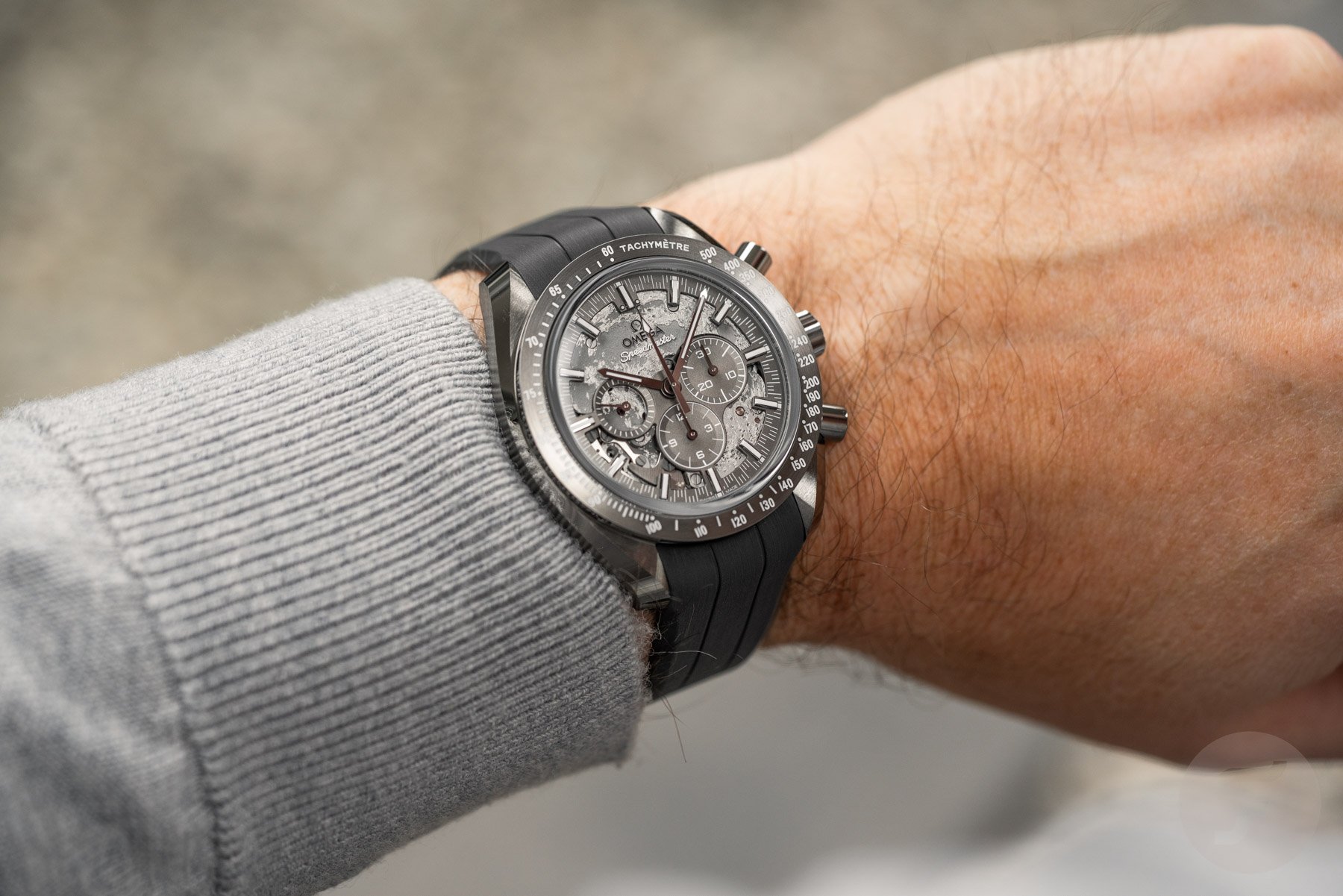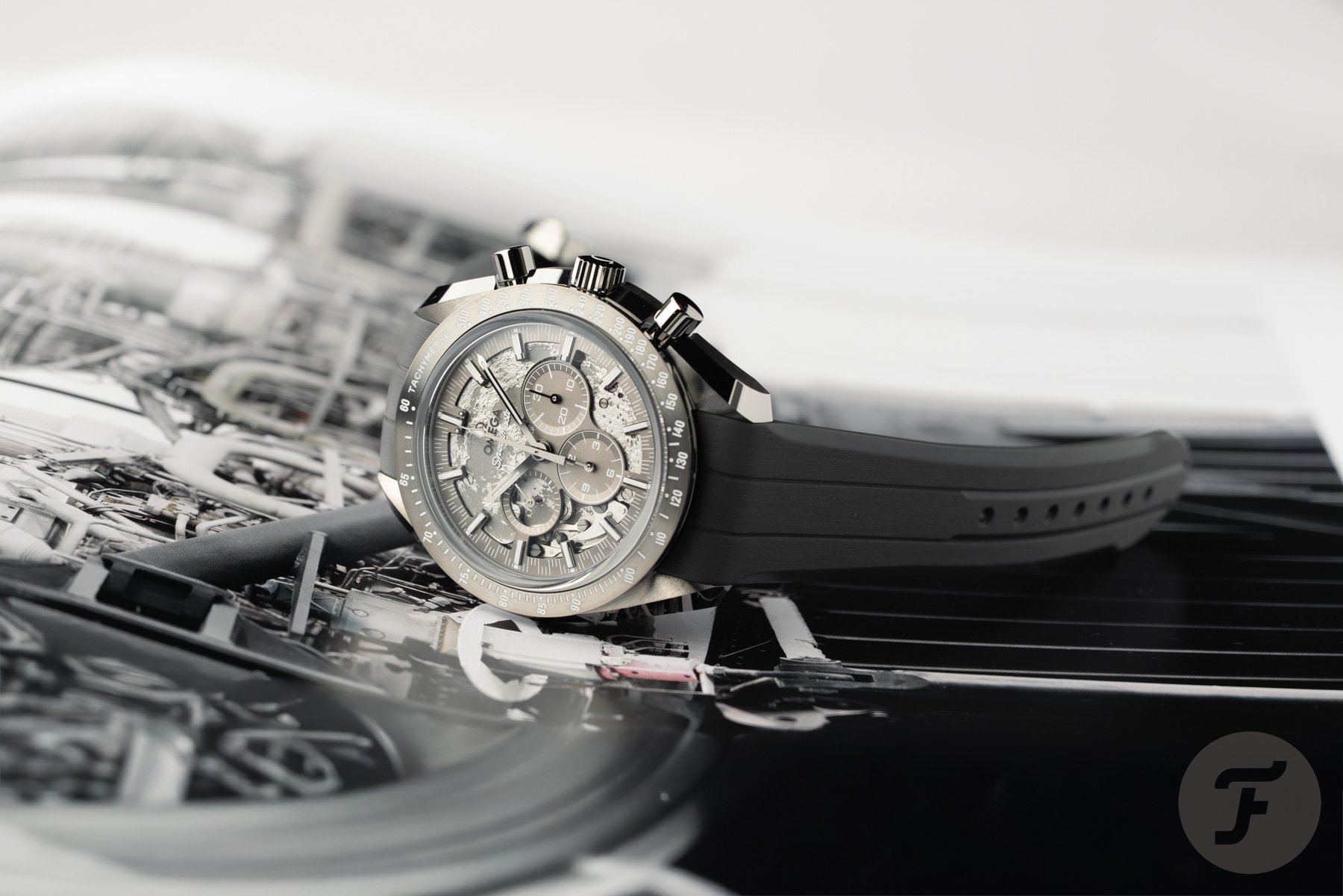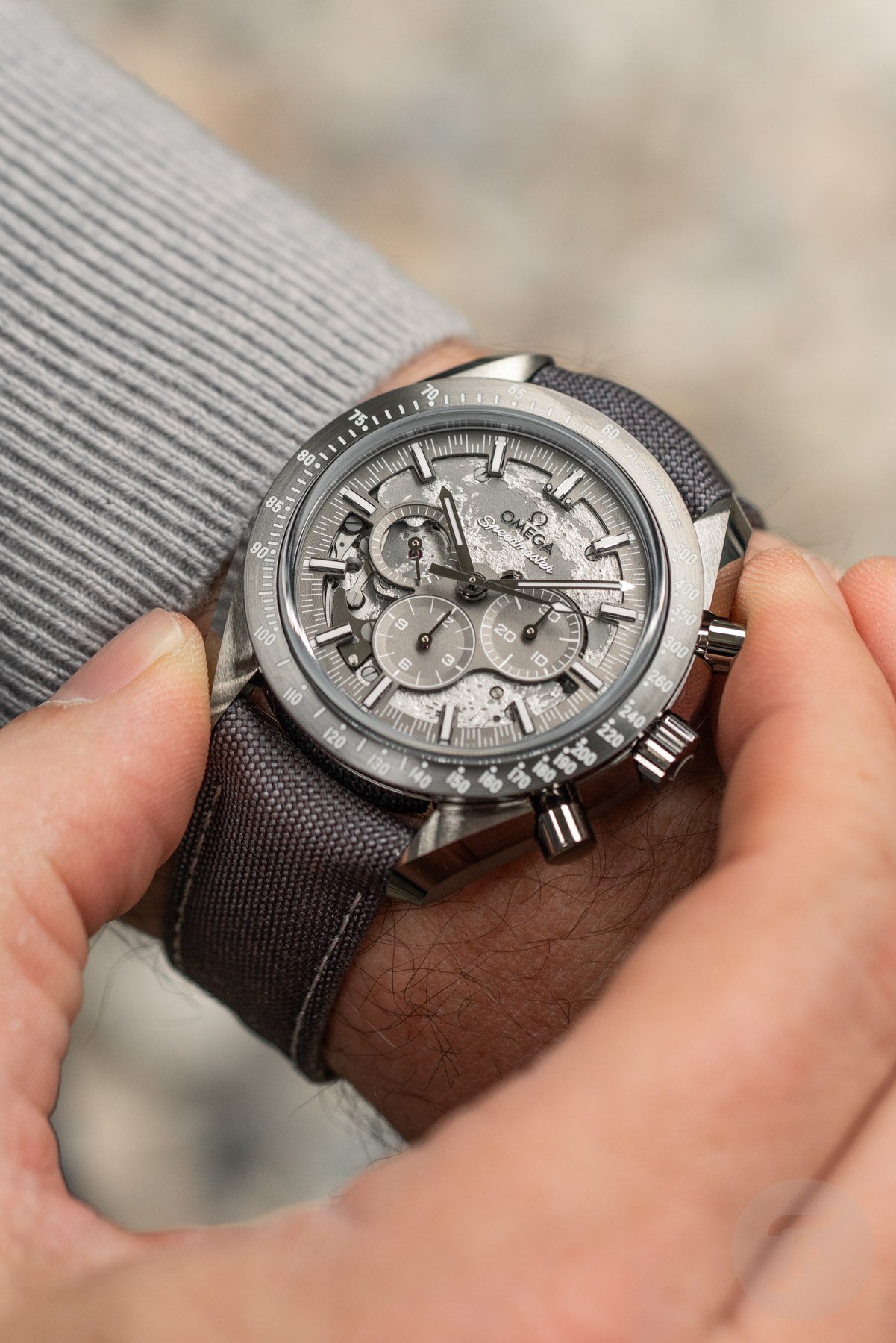Hands-On: The New Omega Speedmaster Grey Side Of The Moon With Caliber 3869
Apollo 8 was the first space flight to reach the Moon. On board were NASA astronauts Frank Borman, Jim Lovell, and William Anders. It took them 68 hours to travel to the Moon, and during the first 66 hours, the spacecraft’s windows were facing Earth.
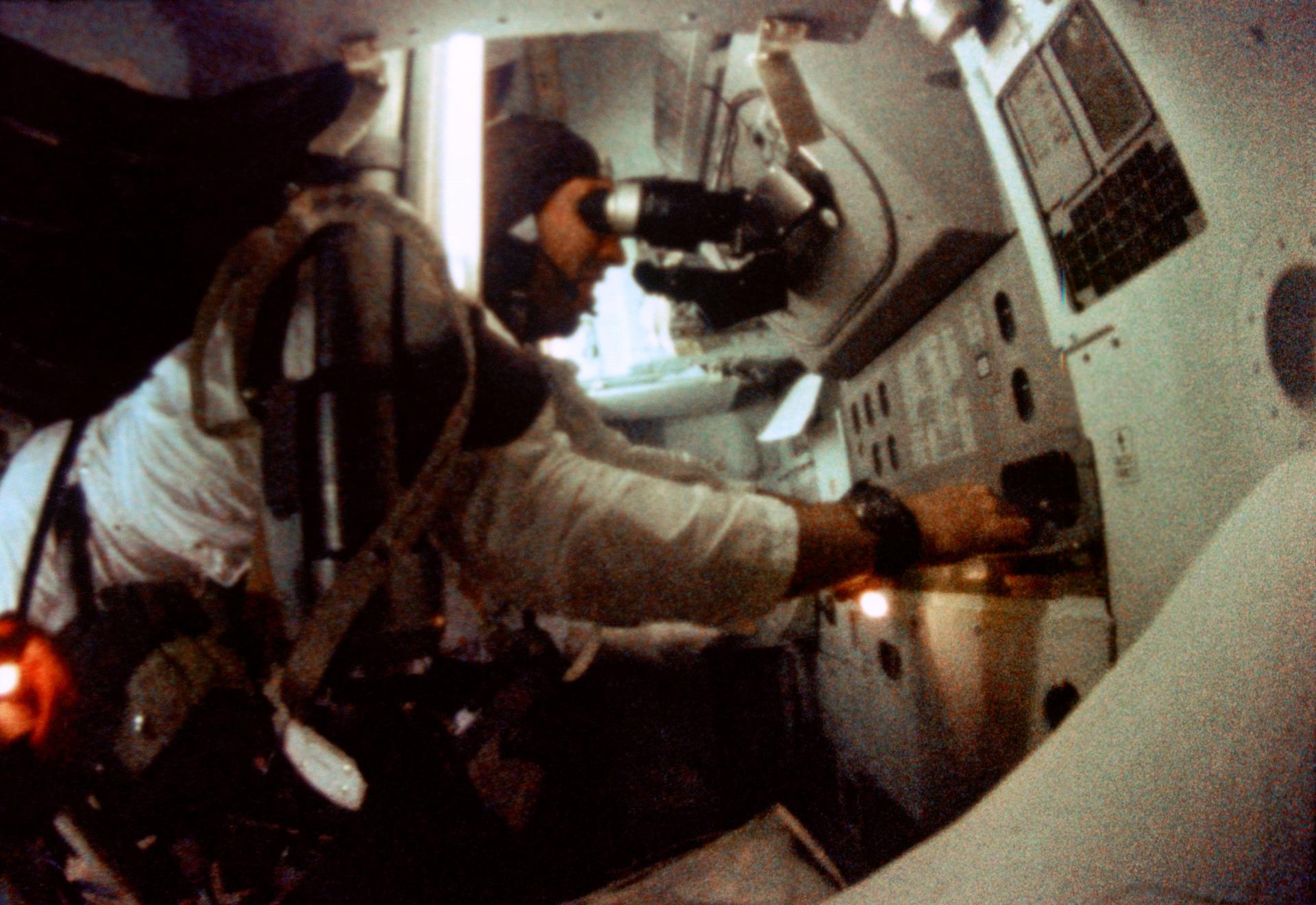
Astronaut James A. Lovell Jr. at the Apollo 8 Spacecraft Command Module’s Guidance and Navigation station during the Apollo 8 lunar orbit mission — Image: NASA
Apollo 8 needed to swing behind the Moon (in total, it would orbit the Moon 10 times), losing radio contact with Mission Control for 32 minutes and 37 seconds. About 70 miles above the Moon’s surface, this changed, and the lunar surface was finally visible to the astronauts.
When they regained contact with Mission Control, astronaut Lovell commented on what he witnessed while passing over the Sea of Fertility: “The Moon is essentially gray, no color; looks like plaster of Paris or sort of a grayish beach sand. We can see quite a bit of detail. … The craters are all rounded off. There’s quite a few of them; some of them are newer.”
Speedmaster Grey Side of the Moon
Omega decided to engrave the first part of Lovell’s description (with British English spelling) on the case back of the new Speedmaster Grey Side of the Moon. This watch is not the first of its kind, as Omega introduced the Grey Side of the Moon in 2014, one year after the debut of the Dark Side of the Moon. The new version, however, replaces the former automatic caliber 9300 with the hand-wound caliber 3869.
Gray ceramic can be found on the case, pushers, and crown, as well as on the clasp (combined with titanium). Due to its hand-wound caliber, the Speedmaster Grey Side of the Moon shares the same case dimensions as the Dark Side of the Moon Apollo 8, including a 12.97mm total thickness. These two are the thinnest ceramic Speedmasters in the catalog.
Apollo 8 and the Grey Side use the caliber 3869
This new Speedmaster Grey Side of the Moon takes influence from both the first Grey Side of the Moon and the Dark Side of the Moon Apollo 8 model, the current version of which came out in early 2024. The Dark Side of the Moon Apollo 8 has a laser-ablated movement that shows the Moon’s surface on its bridges.
The near side of the Moon is on the dial side, while the far side is on the back. The movement in the Grey Side is the same caliber as the one in the Apollo 8. Unlike the new Dark Side of the Moon models we reported on last week, the Grey Side has a hand-wound 3869 movement.
This movement is based on the caliber 3861 but features the special lunar-surface decoration. I am pretty sure I don’t have to thoroughly detail this movement here, as we’ve covered the 3861 on many occasions. The 3869 has the same features, including the Master Chronometer certification, a frequency of 21,600vph, a Co-Axial escapement, and a power reserve of 50 hours.
Skeleton dial
In contrast to the Speedmaster Dark Side of the Moon models, the Grey Side of the Moon does not have a step dial. Instead, it has a gray skeletonized dial with applied luminous hour markers and white markings for the regular minutes and elapsed seconds. The 30-minute and 12-hour chronograph totalizers are solid, while the register for the running seconds is skeletonized. Due to the skeletonization and laser-ablated surfaces, there’s a lot of depth on the face of this watch.
At first, the dial of this new Speedmaster might seem quite busy, but once your eyes adjust, you will discover a high level of detail to admire. The sub-dials at 3 and 6 o’clock have a concentric-grained pattern, which is also present on some of the Moonwatch models.
The smaller sub-dial at 9 o’clock gives you a view of another part of the decorated movement. There’s no Saturn rocket on this one, though. That’s unique to the Dark Side of the Moon Apollo 8 version that remains in the catalog.
Metallic look
Omega’s new gray ceramic Speedmaster has brushed and polished surfaces. The plasma-treated ceramic (hence the slightly higher price than the Apollo 8 model) sometimes has a metallic look, especially as it catches rays of sunlight while on the wrist. At other moments (or angles), it can almost turn to a very dark gray, approaching black. This Speedmaster from the ceramic collection is incredibly versatile.
The Speedmaster Grey Side of the Moon on the wrist
After having spent more than a week with the Dark Side of the Moon models on the wrist, I thought I would also take the new Omega Speedmaster Grey Side of the Moon for a spin.
Most comments I read about the new Dark Side and Grey Side of the Moon models were about their dimensions. To a certain extent, I can understand the sentiment. A 44.25mm diameter is big, as is a 50mm lug-to-lug. But — yes, there’s also a “but” — every one of the people I had try on one of these watches, whether at the office, at a restaurant, or when hanging out with friends, had no idea it had the specified dimensions.
It was only afterward, when I told them it’s a 44.25mm watch, that they responded in surprise. This means that these ceramic Speedmasters wear quite well. Perhaps they won’t if you have particularly small wrists, but they don’t feel that much bigger than a regular 42mm Moonwatch. If you like the looks of the Dark or Grey Side of the Moon, at least give it a shot at your Omega boutique. You might be in for a pleasant surprise. If it is still too big for your wrist size or shape, at least you tried.
Suitable for small wrists?
When we had the 2014 Speedmaster Grey Side of the Moon in for review, my colleague Michael Stockton wrote the following: “Regarding the GSotM on the wrist — wow! I honestly loved it, and I wore it EVERYWHERE. I threw it on with everything, from shorts and a T-shirt to business dress, and it always matched well. It was extremely comfortable on my small wrist and didn’t look at all like an oversized watch.” And he has much smaller (16.51cm / 6.5″) wrists than mine. Click here for his review.
All about comfort
Anyway, I am the first to take off a watch when it’s not comfortable, whether it’s a watch we have for review or something I’m just trying at a boutique or brand event. A watch needs to be comfortable on the wrist; otherwise, you won’t find yourself wearing it, at least not as often as you want to.
However, I have 18cm wrists, and from the moment we received the new Dark and Grey Side of the Moon watches, not a day passed that I didn’t wear one of them nonstop. I am not sure whether the Speedmaster Grey Side of the Moon or the “Dark Vader” is my favorite. That’s something I need to investigate further in the coming weeks. Both have a hand-wound movement and are incredibly comfortable on my wrist.
I have a slight preference for the rubber strap, although the nylon strap that is available for the Speedmaster Grey Side of the Moon looks and feels very silky.
All versions come with the same folding clasp made of titanium and ceramic. It also made me realize I want the rubber strap for my regular Moonwatch.
Smiling
Even now, with the reviews for all the new ceramic Speedmaster models completed, I still find myself grabbing them to wear all day long (until they need to go back to Omega, of course). These new Dark and Grey Side of the Moon watches are just easy to wear, and most importantly, they bring a smile to my face when I look at them on my wrist.
Availability and pricing
The Grey Side of the Moon comes in two variants, as you can see in this article. One is with the rubber strap (ref. 310.92.44.50.06.002), and the other is with the fabric strap (ref. 310.92.44.50.06.001). Both straps have a 21mm width, just like the ones on the Dark Side models. The rubber strap is slightly heavier. With it, the watch weighs 101 grams, while on the fabric strap, the total weight is just 94 grams.
All previous Dark and Grey Side of the Moon models have been discontinued, except for the Apollo 8 edition. You can find an overview here.
Regardless of which strap option you choose, the retail price of the Omega Speedmaster Grey Side of the Moon is CHF 12,800 (ex. taxes) / €16,200 (inc. 21% VAT) / US$16,400 (ex. taxes).

